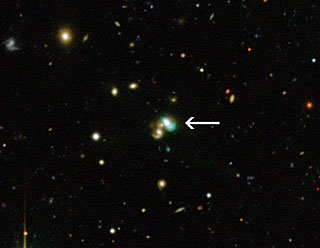Green Bean Galaxies

While Astronomer Mischa Schirmer of the Gemini Observatory was searching for distant galaxy clusters, he came across an object in an image from the Canada-France-Hawaii Telescope that made no sense: it looked like a galaxy, but it was bright green. After reporting his find, he was granted special observing time at short notice to observe it in detail through the VLT (Very Large Telescope – a system of four 8.2 meter telescopes acting in tandem as one large telescope) in Chile. Armed with this new data, he began searching for similar objects through the Sloan Digital Sky Survey — a database of known deep sky objects including almost a billion galaxies. This search yielded only 16 matches, which were then observed through ESO telescopes to confirm that they had the same distinctive colouring. Schirmer had indeed discovered an entirely new type of object.
Although it is the colour that caught Schirmers attention, what really makes Green Beans so strange is the way the entire galaxy glows. In a normal galaxy like our own, most of the light comes from its hundreds of billions of stars, with the rest coming from glowing nebulae. The entire galaxy is filled with very thin, diffuse gas, but this gas only forms nebulae in regions where it’s relatively denser, and near a bright star (or usually, stars) to provide the energy that makes it glow. There is usually a supermassive black hole at the centre of the galaxy, and in-falling material gets heated to extreme temperatures by tidal friction and emits powerful radiation, which causes the gas in these interior regions to glow as well. This region spans only 10% of the galaxy, and is only visible in the nearest galaxies. In Green Beans this region is so large that it covers almost the entire galaxy, because they have, or had, extremely energetic central black holes. J2240, the green bean pictured to the left, actually has a less active black hole than this theory predicts, but astronomers explain this by pointing out that the energy emitted by the black hole can only travel at the speed of light – although it is less active now, the effects of its earlier activity are still lighting up the rest of the galaxy.
